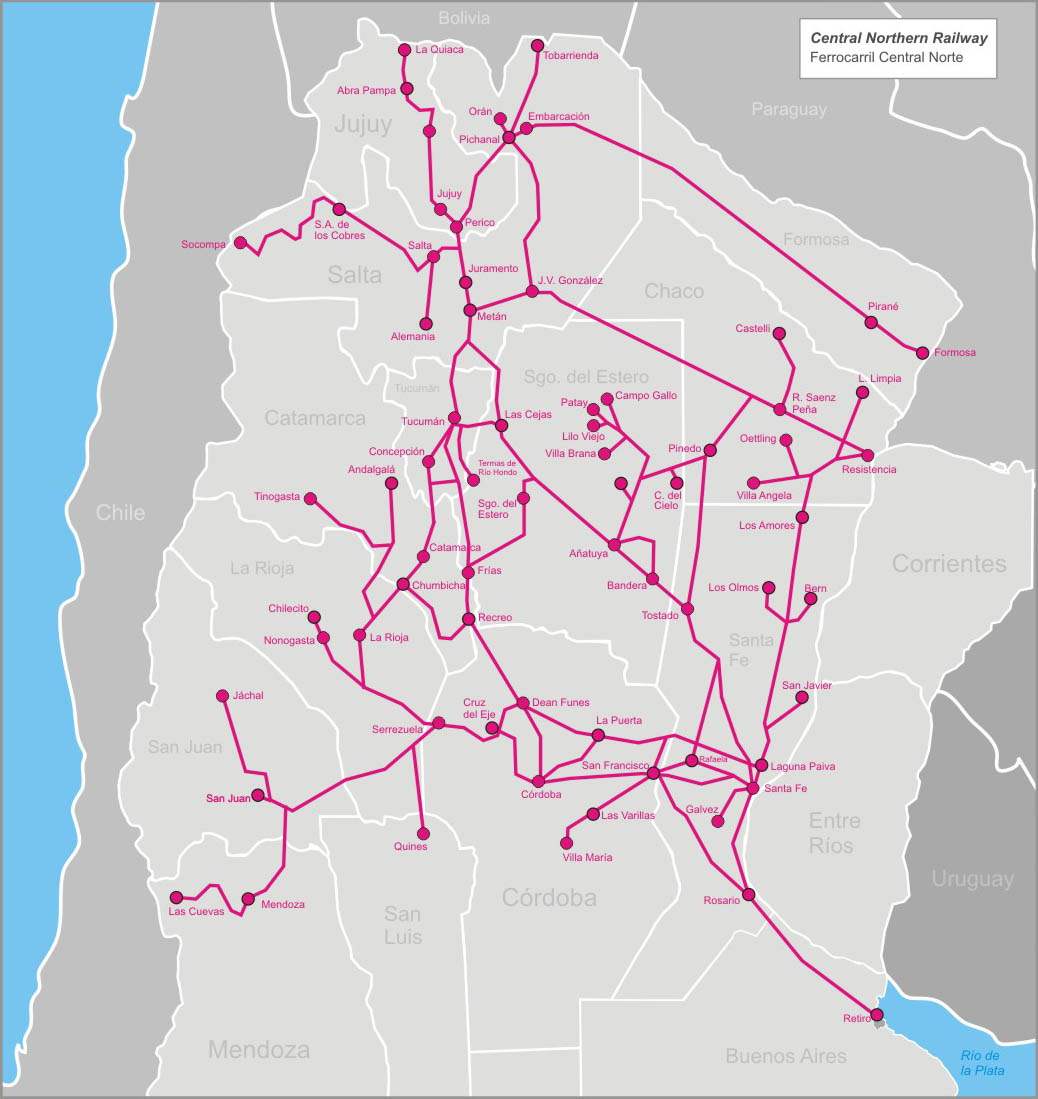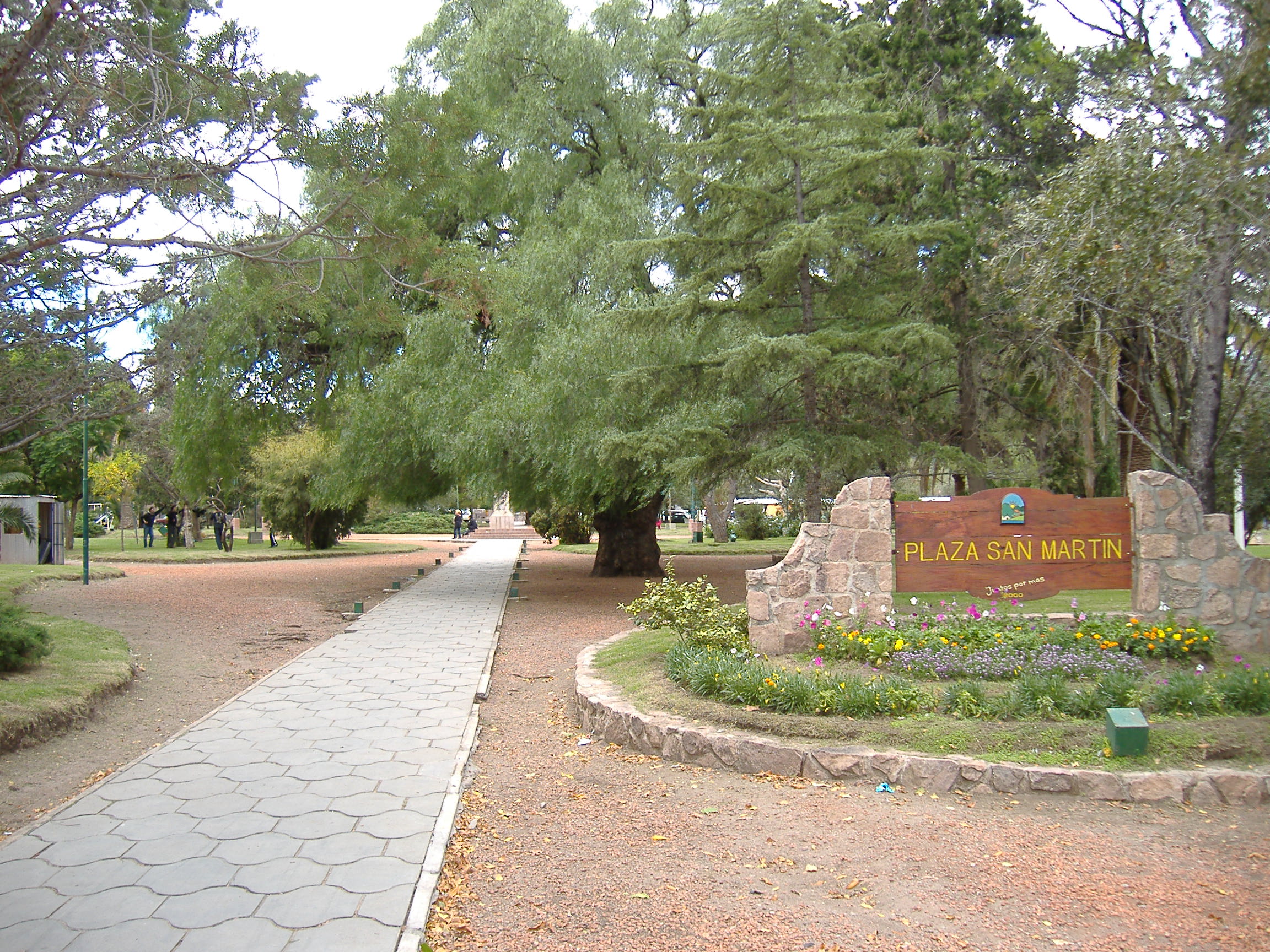|
Tren De Las Sierras
Tren de las Sierras (technically known as the "A-1" branch of the General Belgrano Railway) is a regional rail line in Córdoba Province of Argentina. The line runs from Alta Córdoba to Cosquín, being currently operated by state-owned company Trenes Argentinos. History The rail line was opened on July 2, 1889, to carry both, freight and passengers from Córdoba to Cruz del Eje, operated by British-owned company Córdoba North Western Railway. In 1901 it was taken over by Córdoba Central Railway which operated the branch until 1909 when the company was acquired by the Argentine State Railway. When the Juan Perón administration nationalised the whole railway network in 1948, the CNR became part of General Belgrano Railway, one of the six divisions of recently formed Ferrocarriles Argentinos. By the 1960s the line had its golden age when it carried a big number of passengers of Valle de Punilla, as well as tourists coming from the cities of Córdoba, Rosario and ... [...More Info...] [...Related Items...] OR: [Wikipedia] [Google] [Baidu] |
Argentine State Railway
Argentine State Railway (in Spanish: Ferrocarriles del Estado) was a State-owned railway company of Argentina, established by Law N° 6.757 in October 1909, when José Figueroa Alcorta was the President of Argentina. The company built and operated railway lines in Argentina. History By 1905 the State-owned railway network was 3,490 km length, with the Ferrocarril Central Norte (FCN) being the longest with 1,385 km and the Ferrocarril Argentino del Norte (FAN) with 563 km. Five years later, FCN was 2,135 km long and FAN 1,355 km. In 1925, the Argentine State Railway ranked 2nd among the most important companies in the country, operating a railway network of 6,617 km. By 1936 the railway network had been extended to 9,690 km. Most of the railway lines built by the Argentine state were metre gauge because of financial reasons. In 1937 the State company began to acquire some existing companies with the purpose of competing against British ra ... [...More Info...] [...Related Items...] OR: [Wikipedia] [Google] [Baidu] |
Private Company
A privately held company (or simply a private company) is a company whose shares and related rights or obligations are not offered for public subscription or publicly negotiated in the respective listed markets, but rather the company's stock is offered, owned, traded, exchanged privately, or Over-the-counter (finance), over-the-counter. In the case of a closed corporation, there are a relatively small number of shareholders or company members. Related terms are closely-held corporation, unquoted company, and unlisted company. Though less visible than their public company, publicly traded counterparts, private companies have major importance in the world's economy. In 2008, the 441 list of largest private non-governmental companies by revenue, largest private companies in the United States accounted for ($1.8 trillion) in revenues and employed 6.2 million people, according to ''Forbes''. In 2005, using a substantially smaller pool size (22.7%) for comparison, the 339 companies on ... [...More Info...] [...Related Items...] OR: [Wikipedia] [Google] [Baidu] |
Capilla Del Monte
Capilla del Monte is a small city in the northeastern part of the province of Córdoba, Argentina, located by the Sierras Chicas mountain chain, in the northern end of the Punilla Valley. It has about 11,281 inhabitants as per the . Tourism is the main source of income in Capilla del Monte. The most popular tourist attraction in the area is the Cerro Uritorco, a small mountain only 3 km away from the city, famed around Argentina as a center of alleged paranormal phenomena and UFO sightings. There are many other locations in Capilla del Monte that attract tourists from all over the country. The city also features the tall El Cajón Dam and its large reservoir. Capilla del Monte was founded on October 30, 1585. Its name means "Chapel on the Hill" in Spanish. The area has been used as a special stage for Rally Argentina. Origin 1585 – 1986 The origins of Capilla del Monte can be traced back to the late 16th century, when Lucía González Jaimes, the daughter of th ... [...More Info...] [...Related Items...] OR: [Wikipedia] [Google] [Baidu] |
Trade Name
A trade name, trading name, or business name, is a pseudonym used by companies that do not operate under their registered company name. The term for this type of alternative name is a "fictitious" business name. Registering the fictitious name with a relevant government body is often required. In a number of countries, the phrase "trading as" (abbreviated to t/a) is used to designate a trade name. In the United States, the phrase "doing business as" (abbreviated to DBA, dba, d.b.a., or d/b/a) is used, among others, such as assumed business name or fictitious business name. In Canada, "operating as" (abbreviated to o/a) and "trading as" are used, although "doing business as" is also sometimes used. A company typically uses a trade name to conduct business using a simpler name rather than using their formal and often lengthier name. Trade names are also used when a preferred name cannot be registered, often because it may already be registered or is too similar to a name that is a ... [...More Info...] [...Related Items...] OR: [Wikipedia] [Google] [Baidu] |
Racetrack
A race track (racetrack, racing track or racing circuit) is a facility built for racing of vehicles, athletes, or animals (e.g. horse racing or greyhound racing). A race track also may feature grandstands or concourses. Race tracks are also used in the study of animal locomotion. A ''racetrack'' is a permanent facility or building. ''Racecourse'' is an alternate term for a horse racing track, found in countries such as the United Kingdom, India, Australia, Hong Kong, and the United Arab Emirates. Race tracks built for bicycles are known as ''velodromes''. ''Circuit'' is a common alternate term for race track, given the circuit configuration of most race tracks, allowing races to occur over several laps. Some race tracks may also be known as ''speedways'', or ''raceways''. A ''race course'', as opposed to a ''racecourse'', is a nonpermanent track for sports, particularly road running, water sports, road racing, or rallying. Many sports usually held on race tracks also can occur ... [...More Info...] [...Related Items...] OR: [Wikipedia] [Google] [Baidu] |
Railway Privatisation In Argentina
Railway privatisation in Argentina was a process which began in 1993 under the presidency of Carlos Menem, following a series of neoliberal economic reforms. This primarily consisted of breaking up the state-owned railway company Ferrocarriles Argentinos (FA) and allowing the former lines to be operated by private companies instead of the state. This policy was met with widespread criticism and proved catastrophic for the Argentine railways whose service worsened significantly in the years that followed, with entire lines closing and infrastructure deteriorating beyond repair. Privatisation was ultimately reversed in 2015 with the creation of Nuevos Ferrocarriles Argentinos. Background Since railway nationalisation in 1948, during the presidency of Juan Perón, the network had been operated by the state-owned company Ferrocarriles Argentinos (FA) which comprised the six relatively independent divisions, Sarmiento, Mitre, Urquiza, San Martín, Belgrano and Roca. By the tim ... [...More Info...] [...Related Items...] OR: [Wikipedia] [Google] [Baidu] |
Railway Privatisation In Argentina
Railway privatisation in Argentina was a process which began in 1993 under the presidency of Carlos Menem, following a series of neoliberal economic reforms. This primarily consisted of breaking up the state-owned railway company Ferrocarriles Argentinos (FA) and allowing the former lines to be operated by private companies instead of the state. This policy was met with widespread criticism and proved catastrophic for the Argentine railways whose service worsened significantly in the years that followed, with entire lines closing and infrastructure deteriorating beyond repair. Privatisation was ultimately reversed in 2015 with the creation of Nuevos Ferrocarriles Argentinos. Background Since railway nationalisation in 1948, during the presidency of Juan Perón, the network had been operated by the state-owned company Ferrocarriles Argentinos (FA) which comprised the six relatively independent divisions, Sarmiento, Mitre, Urquiza, San Martín, Belgrano and Roca. By the tim ... [...More Info...] [...Related Items...] OR: [Wikipedia] [Google] [Baidu] |
Carlos Menem
Carlos Saúl Menem (2 July 1930 – 14 February 2021) was an Argentine lawyer and politician who served as the President of Argentina from 1989 to 1999. Ideologically, he identified as a Peronist and supported economically liberal policies. He led Argentina as president during the 1990s and implemented a free market liberalization. He served as President of the Justicialist Party for thirteen years (from 1990 to 2001 and again from 2001 to 2003), and his political approach became known as Federal Peronism. Born in Anillaco to a Syrian family, Menem was raised as a Muslim,"Carlos Menem" ''Encyclopædia Britannica'' but later converted to to pursue a political career. Menem be ... [...More Info...] [...Related Items...] OR: [Wikipedia] [Google] [Baidu] |
Buenos Aires
Buenos Aires ( or ; ), officially the Autonomous City of Buenos Aires ( es, link=no, Ciudad Autónoma de Buenos Aires), is the capital and primate city of Argentina. The city is located on the western shore of the Río de la Plata, on South America's southeastern coast. "Buenos Aires" can be translated as "fair winds" or "good airs", but the former was the meaning intended by the founders in the 16th century, by the use of the original name "Real de Nuestra Señora Santa María del Buen Ayre", named after the Madonna of Bonaria in Sardinia, Italy. Buenos Aires is classified as an alpha global city, according to the Globalization and World Cities Research Network (GaWC) 2020 ranking. The city of Buenos Aires is neither part of Buenos Aires Province nor the Province's capital; rather, it is an autonomous district. In 1880, after decades of political infighting, Buenos Aires was federalized and removed from Buenos Aires Province. The city limits were enlarged to include t ... [...More Info...] [...Related Items...] OR: [Wikipedia] [Google] [Baidu] |
Rosario, Santa Fe
Rosario () is the largest city in the central Argentine province of Santa Fe. The city is located northwest of Buenos Aires, on the west bank of the Paraná River. Rosario is the third-most populous city in the country, and is also the most populous city in Argentina that is not a capital (provincial or national). With a growing and important metropolitan area, Greater Rosario has an estimated population of 1,750,000 . One of its main attractions includes the neoclassical, Art Nouveau, and Art Deco architecture that has been retained over the centuries in hundreds of residences, houses and public buildings. Rosario is the head city of the Rosario Department and is located at the heart of the major industrial corridor in Argentina. The city is a major railroad terminal and the shipping center for north-eastern Argentina. Ships reach the city via the Paraná River, which allows the existence of a port. The Port of Rosario is subject to silting and must be dredged periodica ... [...More Info...] [...Related Items...] OR: [Wikipedia] [Google] [Baidu] |
Ferrocarriles Argentinos
Ferrocarriles Argentinos (abbreviated as FA; ) was a state-owned company that managed the entire Argentine railway system for nearly 45 years. It was formed in 1948 when all the private railway companies were nationalised during Juan Perón's first presidential term, and transformed into the ''Empresa de Ferrocarriles del Estado Argentino'' (EFEA; ). FA managed both passenger and freight services, including long-distance and commuter rail trains in the metropolitan area of Buenos Aires. The company was broken up under the government of Carlos Menem following the privatisation of the railways; however in 2015 the government of Cristina Kirchner revived the brand for use on state-owned railways.Otro salto en la recuperación de soberanía Pagina/12, 16 April 2015. [...More Info...] [...Related Items...] OR: [Wikipedia] [Google] [Baidu] |








.jpg)